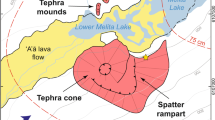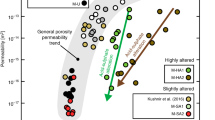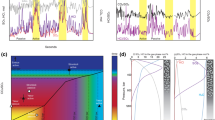Abstract
Terrestrial volcanic eruptions are the consequence of magmas ascending to the surface of the Earth. This ascent is driven by buoyancy forces, which are enhanced by bubble nucleation and growth (vesiculation) that reduce the density of magma1. The development of vesicularity also greatly reduces the ‘strength’ of magma2, a material parameter controlling fragmentation and thus the explosive potential of the liquid rock3. The development of vesicularity in magmas has until now been viewed (both thermodynamically and kinetically) in terms of the pressure dependence of the solubility of water in the magma, and its role in driving gas saturation, exsolution and expansion during decompression. In contrast, the possible effects of the well documented negative temperature dependence of solubility of water in magma has largely been ignored. Recently, petrological constraints have demonstrated that considerable heating of magma may indeed be a common result of the latent heat of crystallization4 as well as viscous5,6 and frictional7 heating in areas of strain localization. Here we present field and experimental observations of magma vesiculation and fragmentation resulting from heating (rather than decompression). Textural analysis of volcanic ash from Santiaguito volcano in Guatemala reveals the presence of chemically heterogeneous filaments hosting micrometre-scale vesicles. The textures mirror those developed by disequilibrium melting induced via rapid heating during fault friction experiments, demonstrating that friction can generate sufficient heat to induce melting and vesiculation of hydrated silicic magma. Consideration of the experimentally determined temperature and pressure dependence of water solubility in magma reveals that, for many ascent paths, exsolution may be more efficiently achieved by heating than by decompression. We conclude that the thermal path experienced by magma during ascent strongly controls degassing, vesiculation, magma strength and the effusive–explosive transition in volcanic eruptions.
This is a preview of subscription content, access via your institution
Access options
Subscribe to this journal
Receive 51 print issues and online access
$199.00 per year
only $3.90 per issue
Buy this article
- Purchase on Springer Link
- Instant access to full article PDF
Prices may be subject to local taxes which are calculated during checkout


Similar content being viewed by others
References
Sahagian, D. Magma fragmentation in eruptions. Nature 402, 589 (1999)
Vasseur, J., Wadsworth, F. B., Lavallée, Y., Hess, K.-U. & Dingwell, D. B. Volcanic sintering: timescales of viscous densification and strength recovery. Geophys. Res. Lett. 40, 5658–5664 (2013)
Dingwell, D. B. Volcanic dilemma: flow or blow? Science 273, 1054–1055 (1996)
Blundy, J., Cashman, K. & Humphreys, M. Magma heating by decompression-driven crystallization beneath andesite volcanoes. Nature 443, 76–80 (2006)
Rosi, M., Landi, P., Polacci, M., Di Muro, A. & Zandomeneghi, D. Role of conduit shear on ascent of the crystal-rich magma feeding the 800-year-BP Plinian eruption of Quilotoa Volcano (Ecuador). Bull. Volcanol. 66, 307–321 (2004)
Wright, H. M. N. & Weinberg, R. F. Strain localization in vesicular magma: implications for rheology and fragmentation. Geology 37, 1023–1026 (2009)
Kendrick, J. E. et al. Extreme frictional processes in the volcanic conduit of Mount St. Helens (USA) during the 2004–2008 eruption. J. Struct. Geol. 38, 61–76 (2012)
Martel, C. & Schmidt, B. C. Decompression experiments as an insight into ascent rates of silicic magmas. Contrib. Mineral. Petrol. 144, 397–415 (2003)
Proussevitch, A. A. & Sahagian, D. L. Dynamics and energetics of bubble growth in magmas: Analytical formulation and numerical modeling. J. Geophys. Res. Solid Earth 103, 18223–18251 (1998)
Ghiorso, M. S. & Sack, R. O. Chemical mass-transfer in magmatic processes. 4. A revised and internally consistent thermodynamic model for the interpolation and extrapolation of liquid-solid equilibria in magmatic systems at elevated temperatures and pressures. Contrib. Mineral. Petrol. 119, 197–212 (1995)
Hess, K. U., Cordonnier, B., Lavallée, Y. & Dingwell, D. B. Viscous heating in rhyolite: an in situ determination. Earth Planet. Sci. Lett. 275, 121–126 (2008)
Mastin, L. G. The controlling effect of viscous dissipation on magma flow in silicic conduits. J. Volcanol. Geotherm. Res. 143, 17–28 (2005)
Kendrick, J. E. et al. Seismogenic frictional melting in the magmatic column. Solid Earth 5, 199–208 (2014)
Kendrick, J. E. et al. Volcanic drumbeat seismicity caused by stick-slip motion and magmatic frictional melting. Nature Geosci . 7, 438–442 (2014)
Lavallée, Y., Hess, K.-U., Cordonnier, B. & Dingwell, D. B. Non-Newtonian rheological law for highly crystalline dome lavas. Geology 35, 843–846 (2007)
Gonnermann, H. M. & Manga, M. Explosive volcanism may not be an inevitable consequence of magma fragmentation. Nature 426, 432–435 (2003)
Papale, P. Strain-induced magma fragmentation in explosive eruptions. Nature 397, 425–428 (1999)
Tuffen, H., Dingwell, D. B. & Pinkerton, H. Repeated fracture and healing of silicic magma generate flow banding and earthquakes? Geology 31, 1089–1092 (2003)
Noguchi, S., Toramaru, A. & Nakada, S. Groundmass crystallization in dacite dykes taken in Unzen scientific drilling project (USDP-4). J. Volcanol. Geotherm. Res. 175, 71–81 (2008)
Stasiuk, M. V. et al. Degassing during magma ascent in the Mule Creek vent (USA). Bull. Volcanol. 58, 117–130 (1996)
Johnson, J. B., Lees, J. M., Gerst, A., Sahagian, D. & Varley, N. Long-period earthquakes and co-eruptive dome inflation seen with particle image velocimetry. Nature 456, 377–381 (2008)
Holtz, F., Behrens, H., Dingwell, D. B. & Johannes, W. H2O solubility in haplogranitic melts—compositional, pressure and temperature-dependence. Am. Mineral. 80, 94–108 (1995)
Ryan, A. G., Russell, J. K., Nichols, A. R. L., Hess, K.-U. & Porritt, L. A. Experiments and models on H2O retrograde solubility in volcanic systems. Am. Mineral. 100, 774–786 (2015)
Liu, Y., Zhang, Y. X. & Behrens, H. Solubility of H2O in rhyolitic melts at low pressures and a new empirical model for mixed H2O–CO2 solubility in rhyolitic melts. J. Volcanol. Geotherm. Res. 143, 219–235 (2005)
Holland, A. S. P., Watson, I. M., Phillips, J. C., Caricchi, L. & Dalton, M. P. Degassing processes during lava dome growth: insights from Santiaguito lava dome, Guatemala. J. Volcanol. Geotherm. Res. 202, 153–166 (2011)
Scharff, L., Hort, M. & Gerst, A. The dynamics of the dome at Santiaguito volcano, Guatemala. Geophys. J. Int. 197, 1–17 (2014)
Johnson, J. B., Lyons, J. J., Andrews, B. J. & Lees, J. M. Explosive dome eruptions modulated by periodic gas-driven inflation. Geophys. Res. Lett. 41, 6689–6697 (2014)
Hornby, A. J. et al. Spine growth and seismogenic faulting at Mt. Unzen, Japan. J. Geophys. Res. Solid Earth 120, 4034–4054 (2015)
Lin, A. M. & Shimamoto, T. Selective melting processes as inferred from experimentally generated pseudotachylytes. J. Asian Earth Sci. 16, 533–545 (1998)
Spray, J. G. in Annual Review of Earth and Planetary Sciences Vol. 38 (ed. Jeanloz, R. F. K. H. ) 221–254 (2010)
Carslaw, H. S. & Jaeger, J. C. Conduction of Heat in Solids 2nd edn (Oxford Univ. Press, 1959)
Harris, A. J. L. & Flynn, L. P. The thermal stealth flows of Santiaguito dome, Guatemala: implications for the cooling and emplacement of dacitic block-lava flows. Geol. Soc. Am. Bull. 114, 533–546 (2002)
Zhang, Y. X. A criterion for the fragmentation of bubbly magma based on brittle failure theory. Nature 402, 648–650 (1999)
Petruk, W. Applied Mineralogy in the Mining Industry 1st edn, 268 (Elsevier, 1990)
Hirose, T. & Shimamoto, T. Growth of molten zone as a mechanism of slip weakening of simulated faults in gabbro during frictional melting. J. Geophys. Res. Solid Earth 110, http://dx.doi.org/10.1029/2004JB003207 (2005)
Acknowledgements
We thank A. Pineda, the staff at the National Institute for Seismology, Vulcanology, Meteorology and Hydrology of Guatemala (INSIVUMEH) and the Policia Nacional Civil de Guatemala for support with the field campaign. This work was supported by a European Research Council Starting Grant to Y.L. on ‘Strain Localisation in Magmas’ (SLiM, grant number 306488) and an Advanced Grant to D.B.D. on ‘Explosive volcanism in the Earth system’ (EVOKES, grant number 247076). J.B.J acknowledges the National Science Foundation EAR-grant number 1151662. This work was partially funded by the European Union’s seventh programme for research, technological development, and demonstration under grant agreement 282759 (VUELCO), and by an AXA grant ‘Risk from Volcanic Ash in the Earth System’. We are grateful to K. Genereau and L. Mastin for constructive reviews.
Author information
Authors and Affiliations
Contributions
Y.L., J.E.K., F.W.v.A., A.J.H., F.B.W., B.J.A., B.M.K. and D.B.D. conceptualized the model. G.C. facilitated fieldwork and supported data analysis. Y.L., C.C., F.B.W., A.J.H., B.M.K. and E.R. performed fieldwork, collected samples and Y.L., F.W.v.A., A.J.H. and J.E.K. analysed the ash. A.J.H., J.E.K. and Y.L. performed the experiments. J.B.J. performed the geophysical analysis. All authors contributed to the manuscript.
Corresponding author
Ethics declarations
Competing interests
The authors declare no competing financial interests.
Extended data figures and tables
Extended Data Figure 1 Grain size distribution of three volcanic ash samples collected during November 2012.
At this proximal sampling location (275 m from the vent), most of the ash recovered is below 200 μm in size and the dominant grain size peaks at around 50 μm. The measurements were made using a laser diffraction particle size analyser from Coulter.
Extended Data Figure 2 BSE image showing the different phases present in the eruptive products at Caliente.
The dome rocks and the volcanic ash samples contain primarily plagioclase (Pl, dark grey), pyroxene (Px, light grey), iron oxides (Ox, white), apatite (Ap, very dark grey) and interstitial glass (Gl, dark grey). Note the absence of vesicles (black, rounded pores) in this dense ash fragment, which contains less than 2% pore space. Despite the fact that there are no vesicles in this ash particle, we note that the edge of the iron oxides and pyroxene crystals are not straight, but rather crenulated and somewhat diffuse.
Extended Data Figure 3 BSE images showing heterogeneous melt filaments present in volcanic ash erupted at Caliente.
a, b, 13 November 2012; c, 26 November 2014. The yellow box in a defines the region of interest displayed in b. Evidence for high thermal input is best represented by the occurrence of frictional melting. The characteristic texture of frictional melting has been noted in a number of volcanic ash particles and from several eruptions (the main text refers to ash from 10 November 2012). The textures associated with frictional melting preserved in the ash erupted on 13 November 2012 and 26 November 2014, suggest that this dynamic of strain localization in magma was active for at least two years.
Extended Data Figure 4 EDS images showing the heterogeneous concentration of various elements in the melt filaments.
a, BSE image showing the area mapped by EDS. EDS maps show the distribution of Fe (b, in green), Ti (c, in blue), and Al (d, in red). Colour-scale values represent X-ray counts per pixel for each energy band in the line type Ka1. During frictional melting of andesite and dacite, selective melting tends to affect the iron-titanium oxides more readily than silicate mineral phases owing to their lower fusion temperature30.
Extended Data Figure 5 Sample assembly setup during rotary shear experiments.
The sketch also highlights the area sliced for thin-section preparation.
Extended Data Figure 6 Frictional melt chemistry.
a, BSE image of the different phases and textures observed in the products of the rotary shear experiments, along with eight numbered locations of geochemical analyses acquired with the EPMA. b, Normalized geochemical composition of major elements for each analysis. Comparison of the chemical analyses with the textures reveals the variable heterogeneity of the rock products by frictional melting. Analyses 1 and 2 present pyroxene crystals in the seemingly undisturbed host rock and as fragments in the melt zone respectively; they do not show any degree of contamination. Similarly, analysis 3 presents a Fe-oxide crystal and analyses 6 and 8 present plagioclase crystals in the host rock which have not been chemically altered by the products of frictional melting. Analysis 4 presents a protomelt consisting of orthopyroxene with high concentration of Fe-oxide. Analysis 5 also presents a protomelt but this time the chemical composition, and in particular the intermediate concentrations of MgO, CaO and FeO, suggests that it is a mixing product of molten plagioclase and orthopyroxene crystals in a ratio nearing 1:1. Analysis 7 presents the geochemistry of the more homogenized central frictional melt zone, resulting from the mixing of the molten crystals described above.
Extended Data Figure 7 Vesicularity gradients developed in the interstitial glass along the edge of the FMZ.
Blue arrows indicate vesicles. We observe no vesicles in the interstitial glass away (>0.4 mm) from the slip zone, and hence no vesicles in the pre-experimental sample.
Extended Data Figure 8 SEM images showing the texture of dome rocks unchanged by subjecting them to 850 °C.
a, Heat applied for 30 min. b, Heat applied for 15 h. In either case, we note no new, spherical vesicles developed in the interstitial glass. This observation is consistent with the fact that the sample density did not change, as determined by helium pycnometry. This observation indicates that even at atmospheric pressure, water is unable to exsolve at magmatic temperature, suggesting that high heat input is necessary to lower the solubility and increase diffusivity to trigger vesiculation.
PowerPoint slides
Rights and permissions
About this article
Cite this article
Lavallée, Y., Dingwell, D., Johnson, J. et al. Thermal vesiculation during volcanic eruptions. Nature 528, 544–547 (2015). https://doi.org/10.1038/nature16153
Received:
Accepted:
Published:
Issue Date:
DOI: https://doi.org/10.1038/nature16153
This article is cited by
-
Oxide nanolitisation-induced melt iron extraction causes viscosity jumps and enhanced explosivity in silicic magma
Nature Communications (2024)
-
Detecting multiscale periodicity from the secular effusive activity at Santiaguito lava dome complex (Guatemala)
Earth, Planets and Space (2022)
-
Direct nanoscale observations of degassing-induced crystallisation in felsic magmas
Contributions to Mineralogy and Petrology (2022)
-
In situ observation of the percolation threshold in multiphase magma analogues
Bulletin of Volcanology (2020)
-
Rheological change and degassing during a trachytic Vulcanian eruption at Kilian Volcano, Chaîne des Puys, France
Bulletin of Volcanology (2020)
Comments
By submitting a comment you agree to abide by our Terms and Community Guidelines. If you find something abusive or that does not comply with our terms or guidelines please flag it as inappropriate.



